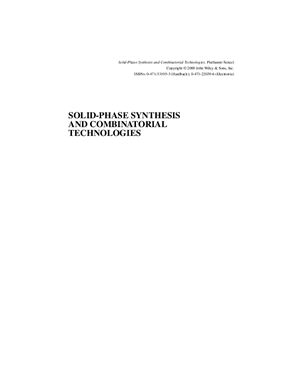A JOHN WI LEY & SONS, INC. , PUBLICATION, 2000. – 620 p.
Combinatorial technologies have been historically associated with pharmaceutical applications, and several chapters of this book are centered around this application. Several other emerging applications, though are exhaustively treated: entire chapters are dedicated to combinatorial libraries from biological sources and to inorganic or polymeric combinatorial libraries, and several sections illustrate the use of synthetic organic libraries in catalysis research, in molecular recognition, and in agricultural research among others.
This book is aimed at three main groups of readers. First, experienced combinatorial chemists and scientists will find coverage of the most recent combinatorial approaches and a detailed multidisciplinary bibliography, including more than 1700 relevant papers, reviews, books, abstracts, and patents, as well as coverage of every relevant aspect of combinatorial technologies. Second, experienced chemists who are ap-proaching SPS and combinatorial technologies for the first time and who wish to enhance their knowledge of the area will discover the basic concepts of SPS and combinatorial chemistry and a critical evaluation of their applications to specific strategies and disciplines. This book, though, is mainly aimed at chemistry students at both graduate and postgraduate advanced course level who will find the concepts of SPS, combinatorial chemistry, and related combinatorial technologies presented in a clear and exhaustive format
The first five chapters are conceived to provide the material for a basic course on solid-phase synthesis and combinatorial technologies, with focus both on explaining the theoretical fundamentals of these disciplines and making them more obvious through many examples; appropriate citations allow the expansion of any subject according to the reader's interests. The following six chapters are dedicated to an expert treatment of combinatorial technologies which hopefully covers most, if not all of the combinatorial hot topics; each of these chapters, either alone or together with several others, can represent the material for advanced, post-graduate courses. A large number of relevant examples will be thoroughly described in Chapters 6 to 11 to clarify each of the theoretical sections. The accessibility of the original papers will allow both the students to follow up an intriguing subject and their professors to expand a specific subject and to make it even more suitable for an advanced, postgraduate course.
The goal to reach such a wide and diverse audience may be overambitious, but a good blend of basic principles and detailedinformation about combinatorial technologies should really be useful for many workers, or future workers, in the field. The homogeneous organization of the book should also be instrumental for the reader and for the student to receive a balanced but complete overview of this new and exciting discipline and hopefully attract the attention of new talented scientists, or soon-to-be scientists, who will eventually contribute to the future development of combinatorial technologies.
Combinatorial technologies have been historically associated with pharmaceutical applications, and several chapters of this book are centered around this application. Several other emerging applications, though are exhaustively treated: entire chapters are dedicated to combinatorial libraries from biological sources and to inorganic or polymeric combinatorial libraries, and several sections illustrate the use of synthetic organic libraries in catalysis research, in molecular recognition, and in agricultural research among others.
This book is aimed at three main groups of readers. First, experienced combinatorial chemists and scientists will find coverage of the most recent combinatorial approaches and a detailed multidisciplinary bibliography, including more than 1700 relevant papers, reviews, books, abstracts, and patents, as well as coverage of every relevant aspect of combinatorial technologies. Second, experienced chemists who are ap-proaching SPS and combinatorial technologies for the first time and who wish to enhance their knowledge of the area will discover the basic concepts of SPS and combinatorial chemistry and a critical evaluation of their applications to specific strategies and disciplines. This book, though, is mainly aimed at chemistry students at both graduate and postgraduate advanced course level who will find the concepts of SPS, combinatorial chemistry, and related combinatorial technologies presented in a clear and exhaustive format
The first five chapters are conceived to provide the material for a basic course on solid-phase synthesis and combinatorial technologies, with focus both on explaining the theoretical fundamentals of these disciplines and making them more obvious through many examples; appropriate citations allow the expansion of any subject according to the reader's interests. The following six chapters are dedicated to an expert treatment of combinatorial technologies which hopefully covers most, if not all of the combinatorial hot topics; each of these chapters, either alone or together with several others, can represent the material for advanced, post-graduate courses. A large number of relevant examples will be thoroughly described in Chapters 6 to 11 to clarify each of the theoretical sections. The accessibility of the original papers will allow both the students to follow up an intriguing subject and their professors to expand a specific subject and to make it even more suitable for an advanced, postgraduate course.
The goal to reach such a wide and diverse audience may be overambitious, but a good blend of basic principles and detailedinformation about combinatorial technologies should really be useful for many workers, or future workers, in the field. The homogeneous organization of the book should also be instrumental for the reader and for the student to receive a balanced but complete overview of this new and exciting discipline and hopefully attract the attention of new talented scientists, or soon-to-be scientists, who will eventually contribute to the future development of combinatorial technologies.

